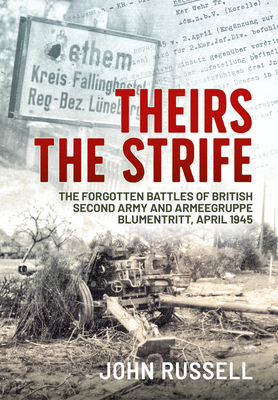Theirs the Strife: The Forgotten Battles of British Second Army and Armeegruppe Blumentritt, April 1945

Theirs the Strife: The Forgotten Battles of British Second Army and Armeegruppe Blumentritt, April 1945
It's early April 1945 and the British Second Army is over the Rhine and advancing across the North German Plain. Its objective is Schleswig-Holstein, with the rivers Weser, Aller and Leine the only remaining obstacles of significance before the Elbe. German forces appear to be in total disarray and British confidence is high, but tempered by the fear of becoming a casualty with the end of the war within touching distance. Unknown to the British, a new division formed from naval personnel and supported by a Waffen-SS battalion of Hitler Youth and some of the last available Tiger and Panther tanks, has been deployed westwards to the Weser and charged with its defense. Despite their inexperience, these are well-motivated troops and determined to acquit themselves to the best of their ability in what will, in all likelihood, be their first and last battle. The destruction of a Churchill tank on the outskirts of Minden on 6 April marks the opening of 11 days of fierce action, and for all the combatants the war is very far from over.
Meticulously researched and published in the 75th anniversary year of the events it describes, Theirs the Strife tells the story of a series of bitter actions fought by VIII and XII Corps to cross the three rivers. Historians have paid little attention to these final weeks, with the few British narratives hurrying from the Rhine to the surrender on L neburg Heath and at best making only passing reference to the actions fought en route. The lack of coverage of the fighting has given rise to a perception that in effect there was none and that the advances through Germany and the Netherlands were trouble-free 'swans'. Nothing could be further from the truth and 21st Army Group suffered heavy casualties during its final battles against the forces of a cornered regime. There is also a commonly-held perception that by 1945 Second Army was at its most potent, when in reality much of it was exhausted and extremely casualty conscious, with the infantry in particular nearly worn out both quantitatively and qualitatively. Furthermore, and largely the product of contemporary photographs and newsreels, there is a misconception that in April 1945 the German Army did little more than surrender. This also is mistaken and many of the German units in the account will fight with courage and resilience. There are therefore more similarities between the opposing combatants than might be assumed and they are both faced with the same challenge:
PRP: 215.64 Lei
Acesta este Prețul Recomandat de Producător. Prețul de vânzare al produsului este afișat mai jos.
172.51Lei
172.51Lei
215.64 LeiLivrare in 2-4 saptamani
Descrierea produsului
It's early April 1945 and the British Second Army is over the Rhine and advancing across the North German Plain. Its objective is Schleswig-Holstein, with the rivers Weser, Aller and Leine the only remaining obstacles of significance before the Elbe. German forces appear to be in total disarray and British confidence is high, but tempered by the fear of becoming a casualty with the end of the war within touching distance. Unknown to the British, a new division formed from naval personnel and supported by a Waffen-SS battalion of Hitler Youth and some of the last available Tiger and Panther tanks, has been deployed westwards to the Weser and charged with its defense. Despite their inexperience, these are well-motivated troops and determined to acquit themselves to the best of their ability in what will, in all likelihood, be their first and last battle. The destruction of a Churchill tank on the outskirts of Minden on 6 April marks the opening of 11 days of fierce action, and for all the combatants the war is very far from over.
Meticulously researched and published in the 75th anniversary year of the events it describes, Theirs the Strife tells the story of a series of bitter actions fought by VIII and XII Corps to cross the three rivers. Historians have paid little attention to these final weeks, with the few British narratives hurrying from the Rhine to the surrender on L neburg Heath and at best making only passing reference to the actions fought en route. The lack of coverage of the fighting has given rise to a perception that in effect there was none and that the advances through Germany and the Netherlands were trouble-free 'swans'. Nothing could be further from the truth and 21st Army Group suffered heavy casualties during its final battles against the forces of a cornered regime. There is also a commonly-held perception that by 1945 Second Army was at its most potent, when in reality much of it was exhausted and extremely casualty conscious, with the infantry in particular nearly worn out both quantitatively and qualitatively. Furthermore, and largely the product of contemporary photographs and newsreels, there is a misconception that in April 1945 the German Army did little more than surrender. This also is mistaken and many of the German units in the account will fight with courage and resilience. There are therefore more similarities between the opposing combatants than might be assumed and they are both faced with the same challenge:
Detaliile produsului









